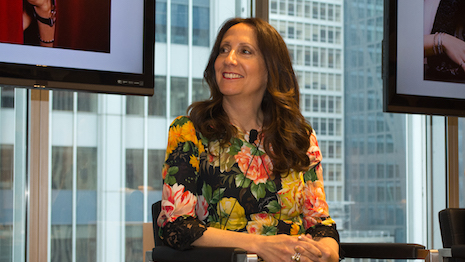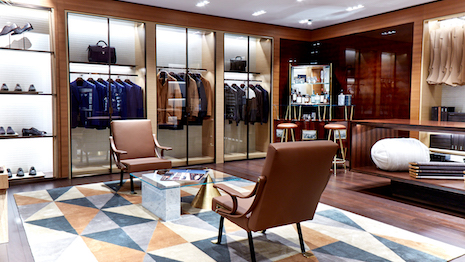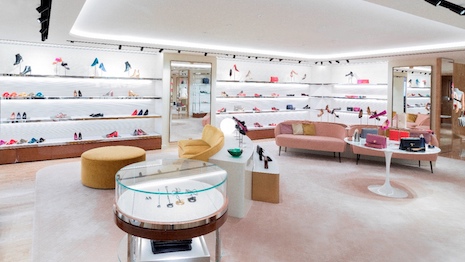NEW YORK – Not all affluents and business professionals have the opportunity to navigate the world of luxury fashion, allowing concierge wardrobe stylists to help fill their sartorial needs.
During a fireside conversation at Women in Luxury 2019 on May 9, concierge wardrobe stylist Laura Solin-Valdina spoke about how she transitioned from working in entertainment to styling professional men and women. As the founder of NYCStylist, she offers bespoke services to her clients to help improve their wardrobes.
“I’m very sensitive to people being able to get their message across,” Ms. Solin-Valdina said. “I build their wardrobes to reflect their personal accomplishments while still speaking to the story that they’re telling and the message that they’re sending.”
Women in Luxury 2019 was produced by Luxury Daily, with venue sponsor UBS
Styling services
Ms. Solin-Valdina has been a stylist for 24 years and launched NYCStylist in 2002. She was drawn to the world of personal styling because of the flexibility it offered her as a mother, as opposed to her previous work in television.
Many affluents have busy careers and are unable find the time to shop in-store or online.
Since the stylist believes clothes are essential to first impressions, she ensures that her clients are comfortable in the pieces she selects.

Laura Solin-Valdina of NYCStylist. Photo by Alice Young for Luxury Daily
Ms. Solin-Valdina asks every client about their profession and lifestyle, as well as what their current wardrobe looks like and what brands they prefer to wear. While certain designers or pieces can find a home in most wardrobes, she looks at each client as an individual.
As she is working with clients, Ms. Solin-Valdina leverages her professional relationships with brands and retailers to purchase styling options for personal fittings. She encourages brands to be open to working with stylists, since many clients are exposed to brands for the first time through styling experiences.
Preparation is a key component of successful fittings with clients.
Ms. Solin-Valdina admits to often buying pieces in multiple sizes. A tailor is also present at each fitting, ensuring every client’s wardrobe has the best possible fit.

Retailer-stylist relationships are important. Image courtesy of Zegna
Other clients will even prefer to purchase items in multiple colors, adapting their new wardrobe for their busy lifestyles.
Closet edits are another essential part of Ms. Solin-Valdina’s styling services, as she helps clients review their current pieces. Most often, unwanted pieces are then consigned to fund future purchases.
Casual closets
One of the trends Ms. Solin-Valdina noted among her clients is a shift towards more casual clothing, even in professional settings.
With global investment banking and securities firm Goldman Sachs embracing a “flexible” dress code, the casualization of business wear has officially reached Wall Street.
Luxury casual wear and streetwear have become fast-growing categories among affluent consumers, particularly millennials. With even the most formal corporations relaxing the dress code standards, brands in the menswear space must keep pace with shifting mindsets (see story).
Affluents continue to spend more on ready-to-wear apparel than luxury accessories. However, even older luxury shoppers are among those looking for more high-end casual wear as they transition out of the workplace (see story).
“Most of my clients are looking for longevity in their clothing and maximizing styling options,” Ms. Solin-Valdina said.
{"ct":"n9YylWxZ+OIIugaX1LW4eL7GN9z2qtbNLHlf26+tbLQA8Lnv+La+eGOvmR\/+jwNpqZ7F29XHDc7zkNmK7nCYrqov0ieFwTj9H0Y6AkilO2qaN+xcE\/2T8WuFnV4iRolOvhKfejirCp0z9TX2\/dwgQkyePuXdWNnFKVw+eWO85Q16UQWfsYRL+Aa6sEWdRNAPmgvGWWE6ADtXC37JxRlEymL7zLP8nBpf5v9Nja607HHZ7zqCY68YnU8YzXSX+6+GkjTuyUjdMYpl5+LAryUGQapfjuQ4IPhXJU0Rb8C0MlFzXkfk81mS5Lyrww5414Aa6HYx8cPux\/pigfHGZn30t9tKo7HFSUdp6cCjn5x\/oKfL6uPw\/qGRJIhjLJ8zAcGAI1SyWF1jp0to6gawwz2tCdzRSvWqp8dMn3o3Dqm8XJeonstlu1iuGhuFcTE6\/mhCj473ipc0w0rxlHXdEMU5wRUdnAMb3u\/cIbkY9LGt8beZRmMJWdPrgI4hUBidaUEGpaP1WVsJ6tfIAmQWGgj4Bym\/20GUWu9CgGmEik7sdjPD9w\/+0pDngQqaKTcLIHI\/RYYSua2wVZWNSf9\/Y+UJae0TC560Vt3U9pic96TsdcVCDh1dSYmg5E1LdLtn7CVauUi11xjRE1SirRG2oZpmSI5akXauM4y3iAtk\/5fZA4mT2dPrL8dmxRZrG1Ju+GCrxdUgKZ3P0p0gjUz0G4UnDvcO6vSbiEMf14qcisqiHqLnZQdln5dAixasH0L+3NAJ6EABFVsCakfJJLVQSLv6HKJ5vihuL9kM5kLzXDD64A0vIk5BmhC6vOIwIsbGqNNc9roWaJN8nQRNNqX+V2Ji6kHzw\/BekVCsvbHGFhk9W4gwC1TngtzTTancGKF5qBuwwbFgtRZ86Js\/\/7ILFBlXETgMIhswLK8A3Mj5k3p711srK8c12ltCwyopOUeqZvdeP++XfsJl\/4ZXazJluEej8zHICqHuX0rqJJPeCk+FMrdCx\/AzEwNhOw3O+Alr+rbRnfUWFnoOKAuCpp4NnezdYkwTgxEBSsyNyCuUlkvD0bTr8jy7tvgd1Ib8oXmWezPEk+b0je41zsjVfq5vFVL9HI\/\/xu37kRSk+OXp0tUCdrKc\/4agujeZ5HBGQYs\/RlareTAsfzqKj5IcpGnuc3bPamQSpvwA9sSwne1yERE6xBRzbEkjImjAJOKkwU+fuQ5nds32JXD7N8hXDz2n\/JvtsXHxSjxY9+XHIpqA7l7e0ud4ud8tqhV1HqGtIxkn2DCvNJjlVL3hi6tHJT6\/+qd01eNVQ0CBL8Pic30pg8zohjCWOaDIT5pt3oqn7DJ5z89\/UdT6fpM3usFYjF+sfxviMNauo1PqI2DF+AMbNZidoqHhaEeHHZ2mW3fJldQJsrB\/XbnNKeU9IM15N4UI+5Z4w\/JslyXsjbfinGTgpA7H3htqta4Le\/gwioq4+vFy2v\/7\/5q1W\/VZlBoivVcoK2rdqkgxFJ2kRXpTdPGB7QQ5eGQpmoiR9D5ByAjPcz9NIUwk3V77in878JK7uhUtjQpgYAeaUWR6bbHGqG\/+ZjXAEBjX+QWX\/qTvNqqH00JPqEqsF3JIGJDAptsRjJU2fzDv0N4k2mr3WFKkqr\/m8V26GVtyvsKmaKqWuaQj67qlaxqw4iHx9zQtLTqDomt0eOE6I39Kz4XsoooT14TN8Ccc9WrG11hiJHP9MhzDs0YSbBGUK0WATeM8O8bL0HszXJpC9Twe320uBZOkpa72hv0EApFFHS91n2TZMhDpkPhgGeK+a3SmHTECHNLDk\/aV7uy11nGOf9KYXIBZHuWGOFjocbhpyC5BwgoMULVWEISodD5eAdPyJnAYEme2wPUcHNbF14mR+5AUuWH84fn1mzAVGo7g1dE0vAwdc0KHOB8G\/BgRwXUN8DS8lklg6zY6GJXLSpWki2WzDVru++abbgbtcm4MkR9\/+L7taRbroSbn2aGEEalUXzHdD84bOYzEtJxkXAiRAgte3T16EH2LS+p5wlCVhoQphfneghs3Upn6tOqUAULPwHEKGYTiq3X53q+OIC\/DWgD9NyIqUD48vDqVoEOCV9SuUvaGbjtHXo7PT9nNa78Q34SpCaaLaQWKzV0ma\/hnNu73aqsfShDknHlc\/6fYrdxR9cWLrPSS9ceIqxtxw0C3LZxqJ0kGd+wPsqErNUrF\/6+hPDLaYWhhtFmCvgU\/i6BGhESR8IYH+LFPbUVoyqryCSDmOQCJHgGPzt5wadA8P3i8I5hcCRLvooJKNFaeg8AwGl+pPedtVKxMPakeFKiKjI2CbBPCVm4hQOX9ROeXCE2\/bI0c9lunFoEs80a9obhfFW+o78130XTAwSrlQF0wyt5+8KwTLn44eKfCQnjDD\/\/yS4z\/kcv4eErBSXg+gLt0ZkhtoDy1J1T6+mlFQB5DPrMqWZ9xDEZE3jkekPMX4\/7EMGElaVn8IlsKZJ4FjB6C2L8ygSBlRKItXgos7LZ1KJJbqTbi9KjqO9DVHU01ThmjoQ9DWAoa7vnni2zK+8wsuoFn9p1BFbD7kjbfxwxXtuLgkBF0W1CLjaW4TrhHSv8uiHsxxr0N7TwJZ6F\/FD26GkSMmNcud\/bsGUrq2zlRa96VoE6+obr0pf4imzopaZNo2eH5v4WJ6AasW38sQ+Es3tYuFaACU\/sCrdkP4Jz3FRP3u0vIlm0Q4WMsEK7v7TWUxSiecEcREx5ef6166Bu6i9JmtM0grukYY2nTqvr5HTPMOunPP0Bj72xVhiKBVOakxxu2tZjMzomlBujsWNWoq1swgjfwCQjpbhdwkguHJeZGWdFtlRxml\/5wzs2r65evEqldLUy2Nggs\/1P3SrcXMWTwcqk0+80wql7T1WO1CvOIErBV1RLJmXhBFAKkhU7Au2wgblhFRb3HLcWBmv481N9jTl1vRk+D\/FDuIvM2wA7fR7RXDIr7b90BQr1fUNdBDQkOXgRouJkPqlXyy9tF42\/FBe13tbZc0ulBEtBi12wA9e7GLhLsXaycDNaMsRh7gDXXzcrFS9Yfx5Jel29rXFJaWr2YDfXMQw7JQGicdNHgNKE+dvl6OtR9swdh99TeN2Y0f0bE2rOks3a+AQs+4UMPXwPRUdntaIK3OA3+PjG0IbNtK\/0ibdmHx4vhaxBm7IZAnMhQvlFivEYUKnsVHyMRitYLpcgJLB1BGsiqdqh9rrR+YIrkwMvjScp5ghtiJAE3QuFqUXFqVYfF+dgCGWXLKJEzUAFJySKcbeP+fQTVjAi9e\/7h22gIMEzGrpTX6KjtYA3P82sDnFBtbVPLtwZxRJHKhbBDSSdQ71dstG0OQjTGdl8Pbzy6Wd4ZBNNKIw9UAZFRsaA3ullXzuc4R9GWmIw+vImTU6WinsIXiYKzf4IBInrIvlc7CFXGWwOA73Bh2rjjbSnEhYOiRA1yq0TY873mLrV4sOgOK+zEpo5uP0UpEzUXewh5P6QJlNVKCDvJo\/JXmu1wWn8xaYKfAXapEOD3ExCAvIeQEcL2mGFBs50W\/4ZV6F9Zb6NznaO1cdzpGRQY+MvY57VujsFENhy5Z9Jirzd+SzNMAilhCJT3c+TDFFY\/EwEmKYtoYNstl4lZvGs730fb4dKimlI5jaOlFvh+hBqBpA6wA5V2tWDLl3kjLhp\/Oe6O08m9yT8E9t+iErrrkH6c9f3v8\/ll1Hevmyxwv5YbaI8LQOw9sKiUJfUhWZcq\/A\/KkO61pJyPKRe+vvUqasrSh1UY8CYfYf8G5eJc68IN9lZ+\/264kb5IWI\/W11qIY4SqN6kutI\/OOHRjUOHqe0m+MVlGhmInoaZlTFg6s8unyuFvImLQnzSGd+BEtfHtGT54W0PYg6mFLzedud02nlVTVFSYyaPR\/UNc3rjTmkyTrw\/q58C9b04iMZa120B0dIErHEnUZaSfPm5o5JybvRmOaIxcuzZtZj01zyaoO8EZ0cRXJh\/x7miSVyKr61a\/zHwMiBLILWEFRjPT8jgtJ8sWi62F9HeyXGhCM+EGw8o15Kcn3iVFGFkraRUxE8KJRT7uwPSVakplXrjR\/OWLAXCDvC5HHXxKxRjFU2B9c9BOwIZ5fULhL3uBOebAq+8zu9jbb4KUDQC+yy3W3SiUc+lJYmSzfaUNSAluxZ\/\/1zwwAx2y9ibmFo49nq28mknUaK+\/TRuv3dC4Q0ATWFrwUZ8Z9J2ZBhBxioEMIRGIbL29b2pNrOlyO12PSmk4Pw4r2XW8GOx4i\/T2ptS82twMlIfyFMGZoRWASDYV23LMgGnmxQQZ8VFR8QD3v3x\/pKJzBW4W0CPKC1hsRyXwiaGA7erVqnEU+DRhnXoX564qASAl8c5ybuaVr\/gw5Pg76dRZuMwoIp3d0z\/oy7DbpuePdZ1jR\/TEmrHi23HNqnCnNwkKL3izkovSY1d+4ADUfQg0Zy8fQPUqsuVDbX+fxYIK0TCeSLjDRp3Qo68dLyucePuPXUIpdhl3HZWLBQjDAmwxutUz2qWE5YY+2hL7o7BfjxJqeJvTN5tsRvH9a9GiylWEx8sFf0uMoCr4abx4hR7Y5Rw6OS370IHt7Q4AzLcjozfzn0H6cXsJtVQe\/0J21w01hDp7mmikIEF2Qf8JxTvuxHTxz\/0vF5DJkujbJXDn46kP1YjSgQQiDtz60Dst9rAfP9QMi111cjKpUE\/VsJIuEajyEr\/uvLfCHMJMIZ6EcVDG+V715W04kZ9P91ESLUZ23Z2Md3kAIs\/nuPZua0C06tr6e9Vv9ICLSJjWFOpB+4nrVDoEuHWDvaXPTBprs9yRZnDFGDDC22F9TrJPmuXFX9RGAablG1TxaetJbpkOlnNMxoRIHEeS8YY9R4hCIoTZSPATbrBV0BsOB8loo\/CLgdBHqtOZPghOVbX7XjSmoy9149phHRbzkLjSq5o8b85e+tuzoe2t5F3la785u+w4meOX6A8CfnP99wQgKvEaB6YjPhX54dIRKz9zFl3ghWoMpRyC7lxdUQIrGFQG7XVf3akISL0FVzpEf8Iz\/EgXGskycJjEh5X+YBvN6XXxcrvtnKHjIUS0Gylh4x5jenJhaLLzoVFioYSJ2MwCTHBGgQPpZDojD+7PDDYLrVVK7p1oIki7a1SYX0oM6etnvFa9\/FQYPJyoXNGcEXU1sAv\/R9ZmTD82VqhUjPK8qbAG71lH41GtQTz6hhXa8rn1OmTEu+u1iFVtHrn0QjhaOgbMKyxOr8w9ksvkBsKU5QwCfVuR2SXpL8Ac6U12Aflc97zv6hSu9Veid\/3dZ6Mo00WQ7APt3K\/ChZxCzXwXrTnsK0DyIlpPWQxwRm15El1SV8CVjXVkJ8cfWs5gu8u4ABOmAXuDtsZcKApuVETtlO2aKqVhG+L0Rfc17ekihJRiBYQpxny8iI76fPcBs5XlBWK7mwBiMiH1eaJdO4Sc7Sse+N2PzyCzL22uzJAGLxXmogyfK15JzGpbmkAXVzaVZrS1qK2Wk9+ZTsjLxRsOhdEhVGnhmYXB9vbFffT9INeXWt7IYhBNbATANekNrgsqxXtV8nprKTCJ\/L+zihCZZuXmqrA4KUnHg80OEcZwZ22t62W50mRMcopIBh5xuWJV4Y2X+DQgBrXPN7Q1YJP5OgwaoxoOo0yxIt4g3cxwkEpmbAdIpr1OJeO0Dd64N8heRg5j3zRGjMmv3geXL706\/jCqHREwPcpwfSlFBLMWoTSGmobWC7ZgwMP\/phYJ6\/j3\/3A0EqFytmPnBSnu3mmx0Yb20pjhIOm5G94EgRCBPD4Gv7Q6Ly1EzO1SzjqIQJE1yahP56RawF5qNXaQDhhO2ksz7+jRtrO27ZxM1qaZQP7P8ZJmtXDja2D84XrfVuW1jm6lCmwZ5yzhP2mUchcle8Oj81trmQiyctTztexWrLC0BrWXm6LrglcjQ+75o05zEDwvbSVyRk7k+lvTrpX0r0eK\/jqruJbCS++E53Zd5\/oaMSdGwsEXXnnQT0wFeE2s\/CQ5IBBqFxe\/MPgAL8lYMKLGMNznrIKLWZxk3AI2zDrmQg9aldnPsgpYwYB2x4XnCLVSqv11XZ58X7+TGVMeKmmbhzXa6g2VbHZWx4JNIAplSqE6yNn99DwYpdtaCwJ6BmNR7HwUn+odqgtVC4GZ2RjHXG5gAm0byp2DrX6WTdo\/uU7I7ZaBov8U4+AVH+WS5NPubJn9BspObZTIzpQUw+fzKneKbP82NbB9i4UJPpbcvAFKMSpklZ7J29ONzZnxzXkN1zFyWIO3aiTcGuEq\/TO8xNY0gFWAhMB9zwSDWbpdDcuHhcyyBpFBmQYdOPsrp7K\/ae\/GM4xsMTVBfs1LgCB0norsso8z+ZLQTUeoyxMfTcr77KPl55w2qoVlkxrErlyoAJ8EfHWjz5rY44xwO4BSBj49fHQqvnsuIeDpPONw1wc2xmLNyGvAhPwJYErLkHTl7BIaFsk1vw0YZQxq4eGCbJ1Nfoi4dJTYT9zWX1WpRYpcZM2uBvThdZp6GM7xyLCxDvT1kfzHA2VVKr1ALH68GjX+HZOhmf9E\/r31vHg0u1vjCtpFw8jvLdW1VmoFvEP7+g9k8\/i31JYFciZ8Wymav3HujMG0zUbY+CuCDGd5C1EiQgGL78R0zu4kP4EyC5g0wWV6ZtuGSVtQO316G\/XJ9qx7tHNnrk6MkAsq4GmyTd6s9y8ULbHYYcSO0qNnj3BICOoYvW8=","iv":"d3932dbe17bd630b1d04258025e10493","s":"892fcd4e740fbdea"}

 Wardrobe stylists can help professionals update their apparel. Image courtesy of Ferragamo
Wardrobe stylists can help professionals update their apparel. Image courtesy of Ferragamo